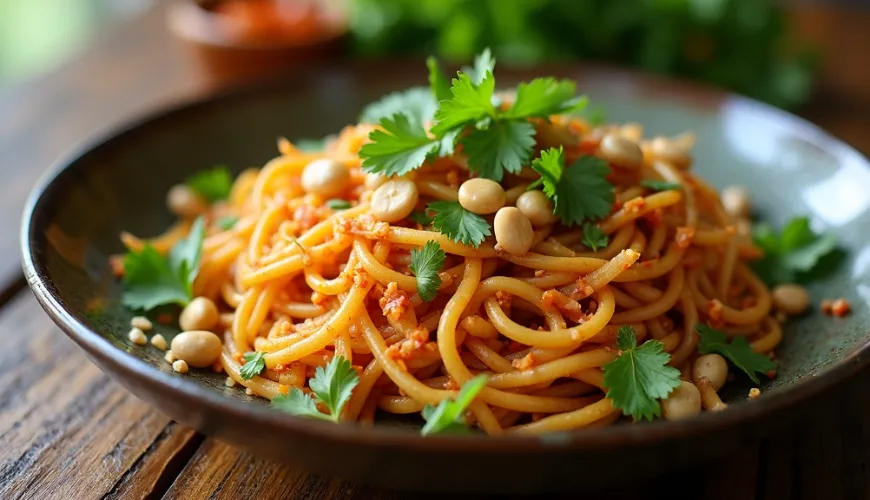
Bami goreng brings exotic flavors to your home kitchen

What Exactly is Bami Goreng and Why Should You Care?
Bami goreng. An exotically sounding name that evokes distant places, the aroma of Asian markets, and the sea splashing somewhere near Bali. In reality, it is one of the most popular dishes of Indonesian cuisine, which has long found its way to European plates. And it's no wonder – bami goreng is a tasty, quick, and incredibly versatile dish that easily adapts to various dietary preferences and available ingredients. Whether you're a vegan, a meat lover, or looking for a way to spice up leftover noodles from the previous day, bami goreng has something to offer.
The name itself comes from Indonesian: "bami" refers to fried noodles, and "goreng" means fried. So, literally "fried noodles." Although it is a traditional Indonesian dish, the influence of Chinese cuisine is evident – especially in the use of wheat noodles and soy sauce. In the Netherlands, which has historical ties to Indonesia, bami goreng is a staple on menus, similar to how svíčková is in the Czech Republic.
Speed and Simplicity Take Precedence
One of the main reasons why bami goreng is gaining popularity is its simple preparation. At a time when most people are dealing with a lack of time and simultaneously desire balanced home-cooked meals, such a dish is a godsend. All you need are a few basic ingredients – noodles, vegetables, a bit of sauce, and optionally a protein of your choice – and within minutes, you have an enticing dish full of flavors on your table.
The basic recipe for bami goreng varies by region and personal preferences. In Indonesia, it tends to be spicier, flavored with chili and shrimp paste sambal. In Europe, it is often prepared with a milder taste and a greater emphasis on fresh vegetables. The advantage is that everyone can adjust the recipe to their needs – vegetarian, vegan, or gluten-free versions are no problem.
A Bami Goreng Recipe You'll Love
If you enjoy dishes that are colorful, playful, and at the same time nutritious, be sure to include bami goreng in your repertoire. The following recipe is a basic version that can be easily modified – for example, by adding tofu, tempeh, eggs, or chicken.
Homemade Bami Goreng Recipe (2 servings)
Ingredients:
- 150 g of wheat or rice noodles (according to preference)
- 1 carrot
- 1 red pepper
- 1 spring onion
- 1 handful of fresh cabbage (white or red)
- 2 cloves of garlic
- 1 teaspoon of fresh ginger (grated)
- 2–3 tablespoons of soy sauce (preferably fermented)
- 1 tablespoon of sesame oil
- 1 teaspoon of sweet chili sauce or sambal oelek
- 1 teaspoon of lime juice
- Optional: peanuts, coriander, fried tofu or egg
Procedure:
- Cook the noodles according to the package instructions, drain, and let them dry. If using rice noodles, rinse them with cold water to prevent sticking.
- Heat sesame oil in a wok or deep pan. Add garlic, ginger, and briefly sauté – just until they release their aroma.
- Add chopped carrot, pepper, and cabbage. Stir-fry on high heat for 3–4 minutes until the vegetables soften but remain crunchy.
- Mix in the noodles, soy sauce, chili sauce, and lime juice. Stir well to combine the flavors.
- Finally, add spring onion and any additional ingredients to taste – such as crunchy peanuts or fresh coriander.
Tip: If you want to enrich the dish with proteins, add pre-fried tofu, tempeh, or egg. In a non-vegan version, chicken or shrimp works well.
Sustainability and a Healthy Lifestyle on One Plate
Bami goreng is not just a tasty exotic dish – it is also an example of how to combine a healthy lifestyle with consideration for the planet. When preparing it at home, you have full control over what goes into the dish. You can use local ingredients, minimize food waste, and reduce the consumption of animal products.
For instance, leftover vegetables from the fridge – broccoli, zucchini, spinach, or peas – can easily be used in bami goreng. And instead of meat, you can opt for plant-based alternatives rich in proteins. This flexibility and diversity make bami goreng an ideal dish for those who want to eat consciously but do not want to compromise on taste.
The health aspects are also worth mentioning. Compared to other popular "quick meals," bami goreng is full of fiber, vitamins, and antioxidants – primarily due to the rich presence of vegetables and minimal processing of ingredients. Additionally, you can control the amount of salt and fat yourself, which is not a given in restaurants or when consuming ready-to-eat meals.
Try our natural products
When Exotic Meets Everyday
A young mother from Brno, who strives to cook healthily and quickly for her family, described how bami goreng became a hit on her home menu. "Originally, I was looking for something that resembles Asian cuisine but wouldn't be expensive or complicated. I discovered a recipe for bami goreng, and since then, I've been making it at least once a week. The kids love it, and my husband wants it with meat. It's great because everyone can add what they like."
This story beautifully illustrates how "distant" dishes can easily become part of everyday home cooking. And it is precisely such dishes, which connect cultural diversity with practicality and availability, that have their irreplaceable place in today's world.
"Once someone discovers that they can make bami goreng in twenty minutes with what they have in the fridge, they won't easily return to instant noodles," says one of the bloggers focused on conscious eating with a smile.
And perhaps that is the magic of bami goreng – it's not just a dish, but a way to eat simply, deliciously, and with respect for nature. Without unnecessary compromises, without complicated rules, just with a desire to explore new combinations and create according to oneself.
In a time when interest in ecology, locality, and sustainability is growing, such recipes become small victories of everyday life. Whether you prepare bami goreng with an egg, tofu, or just a heap of crunchy vegetables, one thing is certain – you will fall in love with this fried noodle delicacy.





